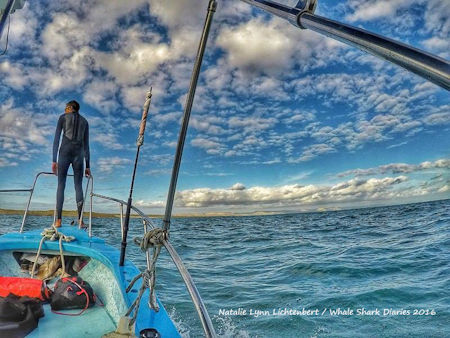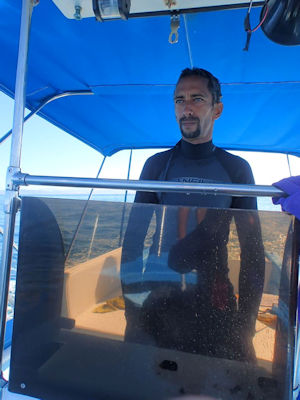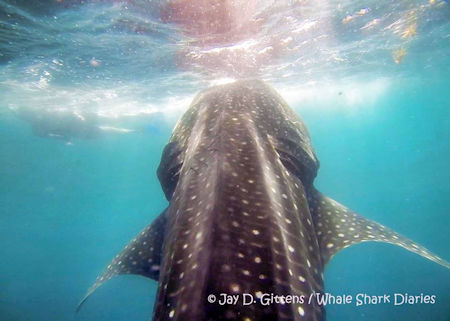 |  |
By Martina

Your feet are buried deep in the white sand, the warm winter of Baja Sur is a delight. The sparkling turquoise water of the Gulf of California is cool, so a wet suit is needed. The great mystery greets you as you sink below the surface. You are entering a watery world to meet with the majestic whale shark. Jay Gittens, based in La Paz, is your guide and makes this exploration exciting with possibly a touch of anxious anticipation. For certain, you are about to have a life changing experience.
Jay is a Brit with a great sense of humor, deep insight and the creator of the Whale Shark Diaries. Jay completed the research for his master’s in Marine Biology in Ensenada, before moving south to La Paz to see these creatures up close and personal. He specializes in whale sharks, in order to support ongoing studies, specifically to better understand and identify important areas of migration for this endangered treasure of the sea. Jay says leaving Great Britain and landing in Baja was a cultural shock to be sure. “Now I have six years on the peninsula and I think if I returned home, it might feel a little weird. I would most definitely miss Baja’s raw beauty and nature’s uniqueness never fails to amaze me.”
There is actually little known about whale sharks and their mating and birthing areas globally.  It is generally believed that whale sharks are born in very deep water and spend the first year of their lives at depths where there are fewer predators than in shallow water. Sightings of a baby, called a neonate, are extremely rare. In this species, a neonate is defined as measuring less than 6 feet. At two years old and six feet they are found in coastal areas for seasonal feeding. A juvenile whale shark is estimated to eat 46 pounds of zooplankton per day. Jay laughs a little at these statistics as it would be nearly impossible to know the exact weight of the zooplankton taken in. This is where science and math are used to approximate. But he does say that feeding is a daily challenge for the enormous shark.
Unlike the pods of gray whales that migrate together from Alaska to Baja Sur, Jay states, “The whale sharks are loners and there are very few examples of interaction between them. If they are found together, they have most likely come to a food source.”
It is generally believed that whale sharks are born in very deep water and spend the first year of their lives at depths where there are fewer predators than in shallow water. Sightings of a baby, called a neonate, are extremely rare. In this species, a neonate is defined as measuring less than 6 feet. At two years old and six feet they are found in coastal areas for seasonal feeding. A juvenile whale shark is estimated to eat 46 pounds of zooplankton per day. Jay laughs a little at these statistics as it would be nearly impossible to know the exact weight of the zooplankton taken in. This is where science and math are used to approximate. But he does say that feeding is a daily challenge for the enormous shark.
Unlike the pods of gray whales that migrate together from Alaska to Baja Sur, Jay states, “The whale sharks are loners and there are very few examples of interaction between them. If they are found together, they have most likely come to a food source.”
There is information of size and weight, but many claims are not scientifically recorded and possibly a fisherman’s tale.

In the Gulf of California region there is an effort to educate and steer seaside communities’ economies from fishing toward a sustainable business of eco-tourism. Jay is very excited about a project that has just been funded that would create a program for a child lacking resources to be trained as a tour guide. The presence of whale sharks in the Gulf of California suggest that the community is lucky. He also stresses, “The once pristine marine environment has been depleted over several decades and is no longer the aquarium of the world Cousteau once described. It’s still very beautiful and the water is rich in nutrients...some from the nearby mangroves and other currents and upwelling.” The whale sharks are widely distributed around the world and have been studied by scientist for years. Still it is a mystery as to their migratory patterns, making it difficult to set up any protected areas.
 On March 18, 2016, the whale shark was moved to the Endangered Species category. The biggest threat to these magnificent creature is us; targeted and non-targeted fishing, commercial demand for meat and oil, shipping and habitat destruction. The whale sharks are filter-feeders. They consume the zooplankton and small fish, then release plankton-free water back into the ocean. The absence of filter-feeders in the world’s oceans would affect the survival of marine organisms that rely on clean ocean water to survive. Little known by the mass population is how dangerously threatened the world’s oceans are at this present time.
On March 18, 2016, the whale shark was moved to the Endangered Species category. The biggest threat to these magnificent creature is us; targeted and non-targeted fishing, commercial demand for meat and oil, shipping and habitat destruction. The whale sharks are filter-feeders. They consume the zooplankton and small fish, then release plankton-free water back into the ocean. The absence of filter-feeders in the world’s oceans would affect the survival of marine organisms that rely on clean ocean water to survive. Little known by the mass population is how dangerously threatened the world’s oceans are at this present time.
Ten years ago, in my own research, I discovered “The Great Pacific Garbage Patch.” The ocean currents continually swirl a plastic mass the size of the state of Texas. I was horrified to learn that in the last ten years it has doubled in size. There are five such gyres around the world as plastic enter the world’s oceans as non-biodegradable toxic waste. Plastic is broken down by the sun into tiny fragments. This threatens many ocean species and filter-feeders like the Whale Shark. Today these particles are ingested by humans in the fish they eat. As of 2016, the idea of cleanup was only in the “concept stage.” Jay suggests that the immense size of the problem ultimately requires stopping the flow of plastic into the oceans rather than the horrendous task of cleaning it up.
It is obvious that Jay Gittens has a passion for discovering the secrets of the whale shark.  Conservation tourism is high on his agenda, as well as continued study. “We host trips for environmentally conscious individuals and groups to join us for informative trips to learn about the biology, life-history and conservation status of these gentle giants.” Jay feels it is extremely important that “people take on the responsibility of educating themselves” before diving. He feels strongly that people should not take a boat tour without an official guide, for safety of both shark and human.
Conservation tourism is high on his agenda, as well as continued study. “We host trips for environmentally conscious individuals and groups to join us for informative trips to learn about the biology, life-history and conservation status of these gentle giants.” Jay feels it is extremely important that “people take on the responsibility of educating themselves” before diving. He feels strongly that people should not take a boat tour without an official guide, for safety of both shark and human.
An important focus is the presentations into “schools, colleges and orphanages to help raise awareness with the younger community of La Paz and involve them in our conservation efforts.” Jay’s own daughter, Kailani, age 4, shows a genuine interest in working with them. She likes to be given the job of “shark spotter.” With just a bit of pride her Dad says, “She keeps asking to get in the water with the sharks...her first in-water whale shark encounter is drawing close.” Very lucky daughter, very lucky Dad.
There is a sense of satisfaction when choosing to make a difference in the world. We can teach our children to love nature and practice family conservation. Do the best we can to reduce the use of plastics; it is far more difficult commitment than it would seem. Decline plastic straws as unnecessary and avoid Styrofoam cups and boxes for takeout. Carry cloth bags for shopping. Participate in beach cleanups. The health of the oceans is humanities’ responsibility, which will support all of marine life and ultimately our own.
Whale Shark season runs from October to May
Contact Jay at 612 197 5824
Email: whalesharkdiaries@gmail.com
Website
References: Wikipedia & Whale Shark Diaries website www.whalesharkdiaries.com/
Martina's email: mteomaya(at)gmail.com

Very excellent service, needed insurance for Mexico, price was fair. The custumer service rep was...

Very easy and great price!